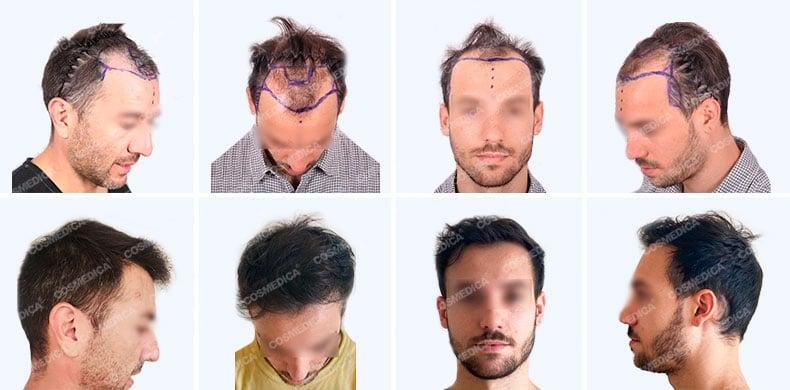
When to start thinking about hair transplant
Contents:
Hair loss is a serious problem for many people. Often the only effective way out of this situation is a hair transplant. Deciding whether or not to have a procedure can be quite a challenge, but it is worth considering using this method as it can significantly improve the appearance in many cases. When is the right time for a transplant? How can you tell if this is the correct solution?
WHEN A LOT BECOMES A PROBLEM
If you think a lot about your hair, pay a lot of attention to how your hair looks in photos, and when you look in the mirror, it might be time to consider a hair transplant. Hair loss often becomes a very important problem that distracts you from thoughts, distracts you from other things. Constantly thinking about your appearance deprives you of the opportunity to enjoy the moment and feel at ease. Hair transplantation is an effective solution to get out of this difficult situation. Thanks to the treatment, you can stop worrying about hair loss.
DIFFIDENCE
For many people, hair loss also leads to the development of complexes and a decrease in self-esteem. Alopecia can effectively undermine self-confidence, and this negatively affects all areas of life - private and professional. Dissatisfaction with one's appearance, of course, does not contribute to contacts with other people and new acquaintances. Restoring thick hair can often restore healthy self-esteem and improve mental well-being. The advantage of a properly performed treatment is stable and natural results. The hair transferred from another part of the head is the same as the rest, grows at the same rate and no visible traces of the transplant are visible. The natural appearance also leads to a higher level of mental comfort after treatment.
BIG HAIR LOSS IN A SHORT TIME
If you notice severe hair loss in a relatively short period of time, it may be time to take advantage of a hair transplant. A systematic check of the hairline will allow you to observe the rate of hair loss and notice the moment when the hair loss becomes intense.
Losing too much hair will make transplantation difficult or even impossible. The procedure requires a sufficient amount of strong hair in the donor area, from where they are transferred to the recipient, thinned. Transplantation is also not carried out if there is a risk that intense hair loss will occur after the procedure.
AT THE BEGINNING OF THE VISIT TO THE SPECIALIST
Before making a final decision on hair transplantation, you should consult with a specialist who will determine the cause of baldness and exclude contraindications to the procedure. Unfortunately, in the case of some health problems, it will not be possible to obtain a satisfactory transplant result even if the procedure is successful. Therefore, before making a final decision, the specialist should conduct a detailed interview and collect as much information about the patient as possible. In some cases, the identification of such disorders is possible through genetic testing. A contraindication to the procedure is advanced diabetes mellitus, unregulated hypertension, serious heart disease, alopecia areata and inflammatory diseases of the scalp. Transplantation should not be performed on people with generalized baldness.
It may also turn out that transplantation is not necessary and other methods can be used to reduce the effects of baldness and prevent its further progression. Many different solutions are used depending on the causes of hair loss, such as taking oral medications or using medications rubbed into the scalp.
REALISTIC EXPECTATIONS
In the case of hair transplantation, correct expectations that correspond to reality are very important. It is worth checking what results can actually be achieved using the available methods.
People who have very high hopes for a transplant are often disappointed with the results. Misconceptions about the consequences of the procedure can only cause disappointment and even deterioration of the mental state due to deceived hopes. During the consultation, the specialist should explain exactly what effects can be expected. It won't always be a perfect re-creation of the pre-baldness hairline. It is worth taking the time to carefully discuss the course and consequences of transplantation with a specialist and develop realistic ideas.
CHOICE OF TRANSPLANTATION METHOD
After deciding on a transplant, another important choice must be made regarding the method of surgery. This is important because the method of the procedure and the devices used will have a big impact on the final results. The most satisfactory results can be achieved using the latest solutions. Currently, the most modern method is FUE using the ARTAS robot. Unfortunately, such a procedure will be quite expensive, but it is a good alternative to the old STRIP procedures and provides a very natural look and a short recovery period after transplantation. STRIP transplantation is cheaper, but not as satisfactory, more invasive, and leaves visible scars that can cause discomfort.
The serious psychological discomfort associated with hair loss is a problem that should not be taken lightly. The rejection of such changes in appearance often causes severe stress and has an extremely negative effect on well-being. For many patients, hair transplantation is a great source of relief and a chance to regain lost confidence. If hair loss has become an obstacle to enjoying life and a source of serious complexes, treatment may be the best way to return to normal life.
Leave a Reply